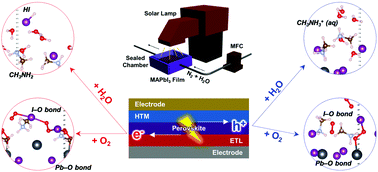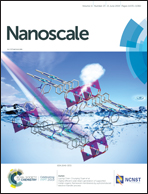An atomistic mechanism for the degradation of perovskite solar cells by trapped charge†
Abstract
It is unmistakably paradoxical that the most vulnerable aspect of the photoactive organic–inorganic hybrid perovskite is its instability against light. Why and how perovskites break down under light irradiation and what happens at the atomistic level of these materials during the degradation process still remain unanswered. In this paper, we found the culprit and verified the mechanism for the irreversible degradation of hybrid perovskite materials from our experimental investigation and ab initio molecular dynamics (AIMD) simulation. We initially found that the electrostatic charges generated by light irradiation and trapped along the grain boundaries of the perovskite crystal result in oxygen-induced irreversible degradation in dry air. This result, together with our previous experimental finding on the same critical role of trapped charges in the perovskite degradation under moisture, suggests that the trapped charges are the main culprit in both the oxygen- and moisture-induced degradation of perovskite materials. Detailed roles of oxygen and water molecules were investigated using AIMD simulation by tracking the atomic motions in the outermost layers of the oxygen- or water-covered methylammonium lead triiodide (denoted MAPbI3 for CH3NH3PbI3) perovskite crystal with trapped charges. In the first few picoseconds of our simulation, trapped charges start disrupting the crystal structure, leading to a short-range interaction between oxygen or water molecules and the compositional ions of MAPbI3. We found that there exist different degradation pathways depending on both the polarity of the trapped charge and the kind of gas molecule. We also verified that a more structurally stable, multi-component perovskite material (with the composition of MA0.6FA0.4PbI2.9Br0.1) showed much stronger resistance against light-induced degradation than MAPbI3 even in 100%-oxygen ambience or humid air.



 Please wait while we load your content...
Please wait while we load your content...